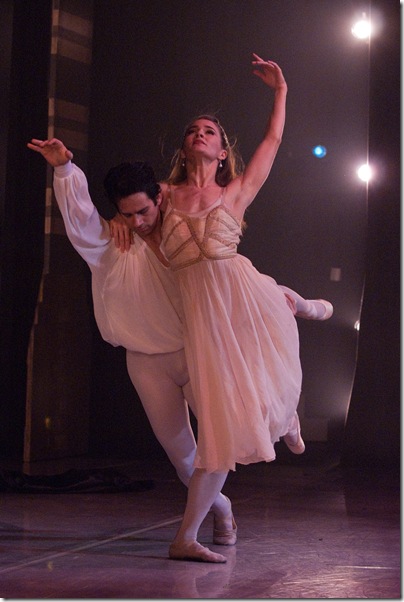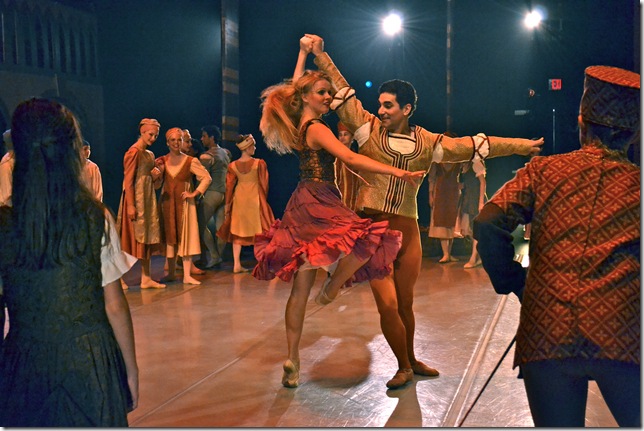It was an interesting experience to see Romeo and Juliet at Ballet Palm Beach in the middle of the Winter Olympics at Sochi; if ice dancing is a somewhat clunky country cousin of the ballet, it has the same general wish to express profound emotion through the arc of the body.
In its performance Feb. 15 at the Eissey Campus Theatre in Palm Beach Gardens, Colleen Smith’s company did a fine, credible job with Sergei Prokofiev’s setting of the Romeo and Juliet story, especially in the performance of its lead ballerina, Lily Ojea, as Juliet. This is Smith’s favorite ballet score, as she told the audience in brief remarks before the ballet, and indeed, the company presented it just two years ago.
And what Smith has done with it is very much in keeping with what she does in general with her large, young company: She gives sections of dancers plenty of work to do, she shifts people ably around the stage to keep the action humming, and she uses straightforward, basic dance moves to illustrate the scenario.
She does all this amid very modest sets and props, further underscoring the essentially educational focus of Ballet Palm Beach. The interesting thing is that she is able to keep some special professional dancers on the team, and that lifts the company to a higher level.
Formally, this was a long and thorough presentation of this great score, and the focus was on Ojea as Juliet. She gave a lovely, precise and moving performance as the doomed archetypal teenager in love, hitting, for example, just the right notes of panic when presented with Count Paris, and a believable clinginess with Romeo as they part in Act III.
Her performance was technically masterful, especially in little details such as her backward walks en pointe, and her beautiful one-leg spins; these helped show the range of her technique, and at the same time, the emotional range of her character. One never got the sense that she was applying herself to the task of difficult movement with grim purpose; rather, she came across with honesty and youthful ardor, and she drew the viewer to her every time she wa s on stage.
It seems to me that Ballet Palm Beach is lucky to have Lily Ojea as its principal female dancer, and that she could probably comfortably carry spotlight roles in a bigger company, and give performances that would reflect well on them and her. Until then, local dance fans should keep her in mind and try to catch her work. She’s a pleasure to watch.
Ojea appears often with Cuban-born dancer Rogelio Corrales, and he was her Romeo here. He is a handsome dancer who makes a persuasive romantic lead, and he had a lot of onstage time in this production. With Ojea he was supportive and strong, easily lifting and supporting her; his individual work, such as in the duel with Tybalt, was vigorous and exciting. His technique is solid, his stamina impressive, and he has a muscularity that makes him most appropriate for roles like these (and it would be good to see him in modern dance some day).
Two supporting male roles, Eric Emerson as Mercutio and Steven Melendez as Tybalt, were quite memorably characterized. Melendez in particular had an intensity that was formidable, and the two had a ferocious onstage rivalry that seized the viewer’s attention, even if you knew precisely what was going to happen. Both dancers were wiry and full of explosive energy, and they made the most of their time onstage with aggressive, thrilling movement.
Also worth of special note were the quintet of women —Megan Dunn, Callie Hamilton, Johanna Hurmemaa, Madeleine Miller and Emily Nichols — who made charming harlots, believe it or not; they were teases rather than sexual aggressors, but great fun to follow. And they were just as delightful to see as Juliet’s friends. Another fine performance came in the comic role of the Nurse, danced in drag by Joseph J. Bucheck III. He makes a very good mime, and he had all the bustle and busybody-ness the role calls for, even in silence.
Smith’s staging was quite traditional, looking much like the standard productions of this work, with good set pieces, especially in the ball scene, which had careful, solemn dancing to the memorable Knights music of this great score. I’ve seen it with more bustle and crowd activity, but this approach’s gentle formality worked well to set up the love-at-first-sight moment when Romeo first sees Juliet.
There’s never any doubt in Smith’s work where dancers are supposed to be or what they’re supposed to be doing, and her ensemble dancers usually do a good job of doing their bit, and did so here, as well. The impression left was that of a nice regional company that trains a lot of dancers and gives them a good exposure to the classics of the genre.
A couple small recommendations: The recorded music was up quite loud in the Eissey, almost too much so. It could probably come down a few decibels. And — this is a minor point —the intermission music was Neapolitan song, played in slushy piano arrangements. If intermission music is thought to be necessary, it should probably stick with the same general feeling of the score being presented rather than be something completely different. Prokofiev’s violin sonatas or his two string quartets would have done nicely, it seems to me.
Ballet Palm Beach’s next production is Don Quixote, with Ludwig Minkus’ score set to a scenario drawn from Cervantes. Shows are set for 7:30 p.m. April 4 and 2 p.m. and 7:30 p.m. April 5 at the Eissey Campus Theatre. Call the campus box office at 207-5900 for more information.

